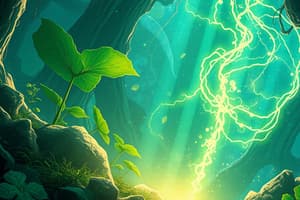Podcast
Questions and Answers
What are the two main stages of photosynthesis?
What are the two main stages of photosynthesis?
- Oxygen and protons
- Thylakoid membrane and electron transport chains
- Chlorophyll and carotenoids
- Light and dark reactions (correct)
Which components are involved in the light reactions of photosynthesis?
Which components are involved in the light reactions of photosynthesis?
- Pigments, photoreaction centers, and electron transport chains (correct)
- Carotenoids, protons, and water
- Dark reactions, thylakoid membranes, and sunlight
- Xanthophylls, chloroplasts, and oxygen
What role do accessory pigments like carotenoids play in photosynthesis?
What role do accessory pigments like carotenoids play in photosynthesis?
- Splitting water molecules
- Forming photoreaction centers
- Supporting roles in light absorption (correct)
- Producing oxygen
Where do the light reactions of photosynthesis take place?
Where do the light reactions of photosynthesis take place?
What is the primary pigment involved in photosynthesis?
What is the primary pigment involved in photosynthesis?
What do photosystems I and II do in photosynthesis?
What do photosystems I and II do in photosynthesis?
Which process releases oxygen into the atmosphere?
Which process releases oxygen into the atmosphere?
What drives the synthesis of ATP during photosynthesis?
What drives the synthesis of ATP during photosynthesis?
Which of the following is NOT a component involved in the electron transport chain during photosynthesis?
Which of the following is NOT a component involved in the electron transport chain during photosynthesis?
What is the role of plastocyanin in photosynthesis?
What is the role of plastocyanin in photosynthesis?
Which compound stores chemical energy in photosynthesis for later use?
Which compound stores chemical energy in photosynthesis for later use?
What is the ultimate source of energy for growth and maintenance in plants?
What is the ultimate source of energy for growth and maintenance in plants?
Flashcards are hidden until you start studying
Study Notes
Overview of Photosynthesis in Higher Plants
Photosynthesis is a fundamental process that allows plants to produce energy from sunlight, carbon dioxide, and water. It occurs in two stages—the light reactions and the dark reactions. Here, we focus on the light reactions, which take place in the thylakoid membranes within the chloroplasts of plant cells.
Light Reactions
The light reactions involve three main components: pigments, photoreaction centers, and electron transport chains. The primary pigment involved in photosynthesis is chlorophyll, with accessory pigments like carotenoids and xanthophylls playing supporting roles in light absorption and protection against damage from excess light. These pigments absorb different wavelengths of light, allowing the plant to capture more solar energy throughout the day.
Chlorophyll molecules are arranged into photoreaction centers, where they undergo excitations upon absorbing light. This excitation energy is transferred through a series of protein complexes known as photosystems I and II, located in the thylakoid membrane.
Photosystems 1 and 2
The most important aspects of photosystems I and II are their ability to split water molecules into oxygen, protons, and electrons. The splitting of water requires high energy input, which comes from sunlight absorbed by chlorophyll and other pigments. Oxygen is released into the atmosphere during this process while the other products remain within the cell to be used later in the dark reactions.
Electron transport chains play a crucial role in transferring electrons generated during the splitting of water to a final electron acceptor. This process involves several proteins and cofactors, including cytochrome b-f complex, plastocyanin, and ferredoxin. The movement of electrons through these chains generates a proton gradient across the thylakoid membrane, which drives the synthesis of ATP—the energy currency of the cell.
Conclusion
In summary, the light reactions of photosynthesis in higher plants convert sunlight into chemical energy stored in ATP and NADPH. These energy-rich compounds are then utilized in the Calvin cycle (dark reactions) to fix carbon dioxide into organic molecules, ultimately providing energy for growth, reproduction, and maintenance. This process has been optimized over billions of years of evolution to maximize efficiency and productivity, making it one of nature's greatest achievements.
Studying That Suits You
Use AI to generate personalized quizzes and flashcards to suit your learning preferences.




